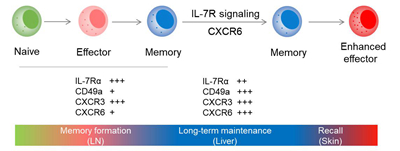A research paper named Memory formation and long-term maintenance of IL-7Rα+ ILC1s via a lymph node-liver axis was published on Nature Communication on Nov. 19th. In this research, they discovered the immune memory ability of ILC1s and revealed its memory formation and maintenance mechanism, providing a new perspective for the thriving field of “ILC Memory”.

The forming procedure IL-7Rα+ ILC1s. (Image by WANG Xianwei)
The innate lymphoid cell (ILC) is an important component of the innate immune system, which is significant in the early immune response to the infection of viruses, bacteria, parasites and other pathogens. Abundant evidence shows that ILCs possess the ability of immune memory, which is a distinctive feature of the adaptive immune system. Such an ability enable them to memorize hapten, MCMV viruses, the stimulations of cytokines, etc. thereby mediating the long-term adaptive immune response. In 2013, the research group of Prof.TIAN Zhigang discovered a specific cell named CD49a+ liver-resident NK (LrNK) for the first time and revealed its immune memory ability (J Clin Invest123, 1444-1456 (2013)). From then on, this kind of cell is classified as ILC1, one of the three major ILC cells. However, the way how LrNK or ILC1 obtains its immune memory and reacts to the specific antigen remains unsolved mystery.
To solve this puzzle, the research group identified a group of memorial immune ILC1s which form in the lymph nodes and stay in the liver. In their experiment, Hapten sensitization initiates the recruitment of IL-7Rα+ ILC1s into skin-draining lymph nodes, where they react to the hapten rapidly by secreting a great amount of IFN-λ and TNF and thus become activated. 48 hours after sensitization, the amount of the ILC1s in the lymph nodes reach a peak. 72 hours later, the ILC1s in the lymph nodes acquire hapten-specific memory potential. After that, the memory ILC1s exit the draining lymph nodes under the assistance of S1PR1 and reside in the liver by connecting itself with CXCL16 in the liver. Moreover, the IL-7 in the sinus hepaticus is crucial to the long-term existence of memory ILC1s. When the organism meet the specific antigen, the IL-7Rα+ILC1s residing in the liver can migrate to the effect site and induce inflammation.
The paper is the latest achievement of the research group of Prof.TIAN Zhigang and Prof.SUN Rui from Hefei National Laboratory for Physical Sciences at Microscale, the CAS Key Laboratory of Innate Immunity and Chronic Disease, School of Life Sciences, University of Science and Technology of China.
This work was supported by the National Nature Science Foundation of China. Professor TIAN Zhigang, Professor SUN Rui and Associate Professor PENG Hui at USTC are corresponding authors of this paper. Dr. WANG Xianwei at USTC is the first author of this work.
(Written by LIU Zige, edited by WU Qiran, USTC News Center)